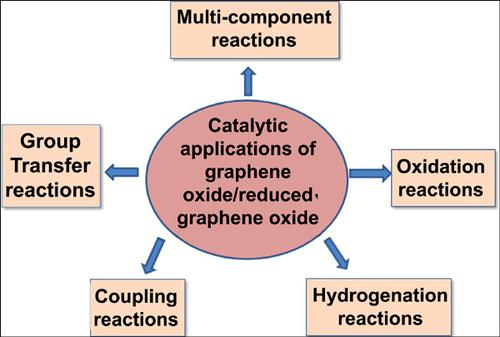Current Organic Synthesis ( IF 1.7 ) Pub Date : 2020-05-01 , DOI: 10.2174/1570179417666200115110403 Vijai K Rai 1 , Suhasini Mahata 1 , Hemant Kashyap 1 , Manorama Singh 1 , Ankita Rai 2

|
This work is based on various bio-reduction of graphene oxide into reduced graphene oxide and their applications in organic synthesis and group transformations. Graphene oxide, with abundant oxygencontaining functional groups on its basal plane, provides potential advantages, including excellent dispersibility in solvents and the good heterogeneous catalyst. This manuscript reviews various methods of synthesis of graphene and graphene oxide and a comparative study on their advantages and disadvantages, how to overcome disadvantages and covers extensive relevant literature review. In the last few years, investigation based on replacing the chemical reduction methods by some bio-compatible, chemical/impurity-free rGO including flash photo reductions, hydrothermal dehydration, solvothermal reduction, electrochemical approach, microwave-assisted reductions, light and radiation-induced reductions has been reported. Particularly, plant extracts have been applied significantly as an efficient reducing agent due to their huge bioavailability and low cost for bio-reduction of graphene oxide. These plant extracts mainly contain polyphenolic compounds, which readily get oxidized to the corresponding unreactive quinone form, which are the driving force for choosing them as bio-compatible catalyst. Currently, efforts are being made to develop biocompatible methods for the reduction of graphene oxide. The reduction abilities of such phytochemicals have been reported in the synthesis and stabilization of various nanoparticles viz. Ag, Au, Fe and Pd. Various part of plant extract has been applied for the green reduction of graphene oxide. Furthermore, the manuscript describes the catalytic applications of graphene oxide and reduced graphene oxide nanosheets as efficient carbo-catalysts for valuable organic transformations. Herein, important works dedicated to exploring graphene-based materials as carbocatalysts, including GO and rGO for organic synthesis including various functional group transformations, oxidation, reduction, coupling reaction and a wide number of multicomponent reactions have been highlighted. Finally, the aim of this study is to provide an outlook on future trends and perspectives for graphene-based materials in metal-free carbo-catalysis in green synthesis of various pharmaceutically important moieties.
中文翻译:

氧化石墨烯的生物还原:(还原)GO在有机合成中的催化应用。
这项工作基于将氧化石墨烯生物还原为还原的氧化石墨烯及其在有机合成和基团转化中的应用。氧化石墨烯在其基面上具有丰富的含氧官能团,具有潜在的优势,包括在溶剂中的优异分散性和良好的多相催化剂。该手稿概述了各种石墨烯和氧化石墨烯的合成方法,并对它们的优缺点,如何克服缺点进行了比较研究,并涵盖了广泛的相关文献综述。在过去的几年中,我们进行了一些基于生物相容性,无化学/杂质的rGO替代化学还原方法的研究,包括闪蒸还原,水热脱水,溶剂热还原,电化学方法,已经报道了微波辅助的减少,光和辐射引起的减少。特别地,植物提取物由于其巨大的生物利用度和用于氧化石墨烯的生物还原的低成本而已被有效地用作有效的还原剂。这些植物提取物主要含有多酚化合物,它们容易被氧化成相应的非反应性醌形式,这是选择它们作为生物相容性催化剂的驱动力。当前,正在努力开发用于还原氧化石墨烯的生物相容性方法。已经在各种纳米颗粒的合成和稳定中报道了这种植物化学物质的还原能力。银,金,铁和钯 植物提取物的各个部分已被用于绿色还原氧化石墨烯。此外,该手稿描述了氧化石墨烯和还原氧化石墨烯纳米片的催化应用,将其作为有效的碳催化剂用于有价值的有机转化。在本文中,已着重研究了重要的工作,这些工作致力于探索石墨烯基材料作为碳催化剂,包括用于有机合成的GO和rGO,包括各种官能团转化,氧化,还原,偶联反应和多种多组分反应。最后,本研究的目的是对各种药学重要部分的绿色合成中无金属碳催化中石墨烯基材料的未来趋势和前景提供展望。着重研究了致力于探索石墨烯基材料作为碳催化剂的重要工作,包括用于有机合成的GO和rGO,包括各种官能团转化,氧化,还原,偶联反应和多种多组分反应。最后,本研究的目的是对各种药学重要部分的绿色合成中无金属碳催化中石墨烯基材料的未来趋势和前景提供展望。着重研究了致力于探索石墨烯基材料作为碳催化剂的重要工作,包括用于有机合成的GO和rGO,包括各种官能团转化,氧化,还原,偶联反应和多种多组分反应。最后,本研究的目的是对各种药学重要部分的绿色合成中无金属碳催化中石墨烯基材料的未来趋势和前景提供展望。











































 京公网安备 11010802027423号
京公网安备 11010802027423号